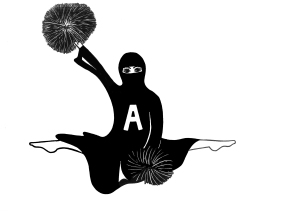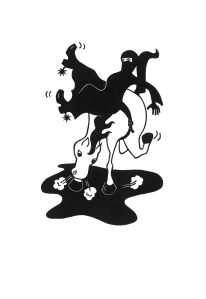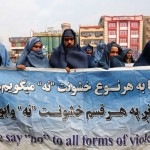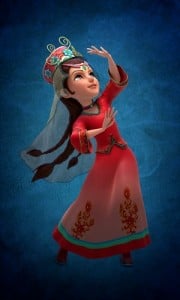Burqa, burqa, burqa. Will we ever reach the stage where there is nothing more to say on the subject? Sometimes I think we’ve covered every angle of critique, but then there comes yet idiocy to be challenged. Worse still, this is idiocy in the name of art. Witness artist Rachel Joy’s latest work.

“FundaMattel: If Barbie Wore A Burqua explores fundamentalism (in its many guises), materialism and constructions of femininity. Mattel is the home of Barbie, an extremist representation of women. If Barbie was a real woman she would fall over because her proportions would make it impossible for her to stand. Barbie, in all her incarnations, is impossible and the burqua makes it equally impossible for women to choose a physically active lifestyle. FundaMattel tries to draw attention to a continuum of fundamentalism where barbie and the burqua both represent extreme constructions of what it means to be female. The project aims to ask questions about these constructed female identities and uses humour as a way of exposing the farce. I hope people will consider where the true power lies in these constructions of femininity.”
What FundaMattel: If Barbie Wore A Burqua consists of are ten black-and-white lino cut prints of, in order: a women in a burqa playing the guitar, a women in a burqa going mountain walking, a group of women in burqas making peace gestures and holding a sign saying “freedom” in Arabic, a woman in a burqa on a motorbike, a woman in a burqa on horseback, a goalkeeper in a burqa, a woman in a burqa cooking a barbeque, three women in burqas doing synchronised swimming, a woman in a burqa playing roller derby, a woman in a burqa cheerleading.
First point. The word “burqa” usuall refers to an all-covering garment, with a mesh covering the eyes. None of the women featured in Joy’s work have their eyes obscured, so one can easily conclude that they are wearing niqab + hijab + abaya. So Joy hasn’t even got the name of the garment right.
Now onto meatier issues, the Barbie/Burqa dichotomy. This oft used trope needs to die in a fire, not just because it is a hideous cliche (although it is), but because it is really, really offensive to compare Muslim women to dolls, that is, inanimate objects with no agency, voice, feelings or humanity.
Yes, there is the whole “representation of femininity” argument, but to equate Muslim women to a toy on the ground of their clothing is reductive and insulting. A Barbie is a manufactured item which cannot speak for itself… does it really need to be spelled out why there is such a huge difference?

Further teeth gnashing can be had at the statement that “Barbie[…] is impossible and a burqa makes it equally impossible for women to choose a physically active lifestyle.” Having already discussed the crassness of the Barbie/Burqa comparison, let’s examine where Joy got her concept of the sporting lives of Muslim women. Joy is apparently an ESL teacher; she states that some of the women in burqas she taught were “very spirited” (intriguingly, this adjective tends to be used about children), “yet it seemed the burqa was a hindrance to their physical expression.” “It seemed?” So did she ask them their thoughts on niqab wearing and physicality, or did she just assume? In her lengthy blog post describing her work, there are no direct quotes from Muslim women whatsoever. We don’t know what her supposed muses’ thoughts were on the matter, nor their reaction to her work.
Joy does acknowledge that, in her words,
“I have never felt entirely comfortable with the idea that women who wear the burqua choose to do so out of blind religious faith or compliance with patriarchal codes of behaviour, that they are experiencing some sort of false consciousness seems to me rather patronising and simplistic.”
And yet she follows this by “[trying] to imagine what they might become were they not so encumbered,” still assuming them to be “encumbered” in ways that they might not (or might, we don’t know) describe themselves.
When discussing the actual images, Joy states that some of the images are very funny, though apparently this humour is meant to unveil (bad-dum -tish) Western attitudes about the burqa and the burqa’s limiting effect on women’s choices. In case you were hiding in a Fortress of Infinite Solitude somewhere and have missed the not only the endless discussion upon the evils of the burqa, but also, the legislation enacted against Muslim women’s face coverings.
However, considering the lack of input from Muslim women, I am unsure how Joy can claim to not be laughing at Muslim women. While there are indeed cultural, social, economic, political and safety issues that impede some Muslim women’s access to certain sport and leisure activities, whether they wear a burqa or not, the idea that pointing with amusement at Muslim women undertaking sporting activities is somehow going to empower them is badly misplaced. One only has to look at the reaction to Mecca Laalaa’s appointment as a Australian lifeguard while wearing a burqini, to see that such outside attention can swiftly turn into hostile mockery and even if well intended, is an unwanted burden in Muslim women’s lives.
One print in particular emphases Joy’s lack of knowledge: print number 4, the “Arab Spring Burqa.” Is she unaware of the protests of women in Yemen, where women with covered faces did go on the streets and demand their freedom? Or that in Syria, women protesters are using face coverings to protect their identities?
It is nigh on impossible to say anything positive about these pieces. One could mention that no doubt her intentions were good, but 1) Intentions are not magic and 2) A non-Muslim using “humour” to posit the discussed-to-the-point-of-tooth-erosion opinion that face coverings are restrictive is a dubious endeavour, like any other assumption about Muslim women that does not centre us or our voices. How can “laughter be subversive” when Muslim women aren’t in on the joke?
Even the artwork itself seems to be incredibly derivative of Mariane Satrapi’s work, to which Joy denies as using as a direct influence, but concedes there may be stylistic similarities.
Finally, in one last misfire, Joy uses the quote “Women is the n***** of the world,” stating that it “is still true today.” Latoya Peterson has already done a pretty solid take-down of this claim in a different context; as she points out, this statement is rather problematic and offensive from a racial angle, but those are the mistakes made when you talk about people and not to them.











